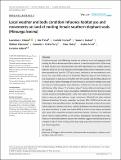Files in this item
Local weather and body condition influence habitat use and movements on land of molting female southern elephant seals (Mirounga leonina)
Item metadata
| dc.contributor.author | Chaise, Laureline L. | |
| dc.contributor.author | Prinet, Iris | |
| dc.contributor.author | Toscani, Camille | |
| dc.contributor.author | Gallon, Susan L. | |
| dc.contributor.author | Paterson, William | |
| dc.contributor.author | McCafferty, Dominic J. | |
| dc.contributor.author | Théry, Marc | |
| dc.contributor.author | Ancel, André | |
| dc.contributor.author | Gilbert, Caroline | |
| dc.date.accessioned | 2018-05-21T11:30:08Z | |
| dc.date.available | 2018-05-21T11:30:08Z | |
| dc.date.issued | 2018-05-20 | |
| dc.identifier | 253137427 | |
| dc.identifier | 19ee48b8-5b9d-4732-8c09-fdccae067138 | |
| dc.identifier | 85047444819 | |
| dc.identifier | 000436799100009 | |
| dc.identifier.citation | Chaise , L L , Prinet , I , Toscani , C , Gallon , S L , Paterson , W , McCafferty , D J , Théry , M , Ancel , A & Gilbert , C 2018 , ' Local weather and body condition influence habitat use and movements on land of molting female southern elephant seals ( Mirounga leonina ) ' , Ecology and Evolution , vol. Early View . https://doi.org/10.1002/ece3.4049 | en |
| dc.identifier.issn | 2045-7758 | |
| dc.identifier.other | crossref: 10.1002/ece3.4049 | |
| dc.identifier.uri | https://hdl.handle.net/10023/13416 | |
| dc.description | The overall study was funded by the Institut Polaire Français Paul-Emile Victor (IPEV program 1037 HEnergES), doctoral fellowships of French Ministry of Higher Education and Research, the University of St Andrews, the Marine Alliance for Science and Technology for Scotland (MASTS), and the Carnegie Trust for the Universities of Scotland. | en |
| dc.description.abstract | Southern elephant seals (Mirounga leonina) are known to move and aggregate while molting, but little is known about their behavior on land during this time. In this study, 60 adult females were monitored (23 with GPS tags) during four molting seasons, between 2012 and 2016 at Kerguelen Archipelago, Indian Ocean. Population surveys were recorded each year (N = 230 daily counts), and habitat use was analyzed in relation to the stage of the molt and local weather. Based on stage of molt, habitat use, and movements on land, we classified the molt of elephant seals into three phases: (1) a “search phase” at the initial stage of molt when grass and wallow habitats were used and characterized by greater mean distances travelled on land per day compared with the two other phases; (2) a “resident phase”: during initial and mid‐stage of molt when animals were found in grass and wallow habitats but with less distance moved on land; and (3) a “termination phase” at the final stage of molt where grass and beach habitats were occupied with no change in distances. Windchill and solar radiation influenced individual distances moved per day (mean 590 ± 237.0 m) at the mid‐ and final stage of molt such that animals travelled greater distances on days of low windchill or high solar radiation. Individual variation in distance moved and relative habitat use were also linked to body mass index (BMI) at arrival on the colony, as females with higher BMI moved less and preferred beach habitat. Moreover, the individual rate of molt increased with the use of wallows. Aggregation rate tended to be negatively correlated with distances moved. We therefore suggest that individuals face an energetic trade‐off while molting, balancing energy expenditure between movement and thermoregulation. | |
| dc.format.extent | 10 | |
| dc.format.extent | 774464 | |
| dc.language.iso | eng | |
| dc.relation.ispartof | Ecology and Evolution | en |
| dc.subject | Body mass | en |
| dc.subject | GPS loggers | en |
| dc.subject | Habitat selection | en |
| dc.subject | Marine mammals | en |
| dc.subject | Meteorological conditions | en |
| dc.subject | Molt | en |
| dc.subject | Pinnipeds | en |
| dc.subject | Population counts | en |
| dc.subject | QH301 Biology | en |
| dc.subject | DAS | en |
| dc.subject | SDG 14 - Life Below Water | en |
| dc.subject.lcc | QH301 | en |
| dc.title | Local weather and body condition influence habitat use and movements on land of molting female southern elephant seals (Mirounga leonina) | en |
| dc.type | Journal article | en |
| dc.contributor.institution | University of St Andrews. School of Biology | en |
| dc.contributor.institution | University of St Andrews. Sea Mammal Research Unit | en |
| dc.identifier.doi | 10.1002/ece3.4049 | |
| dc.description.status | Peer reviewed | en |
This item appears in the following Collection(s)
Items in the St Andrews Research Repository are protected by copyright, with all rights reserved, unless otherwise indicated.

